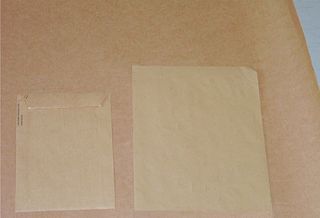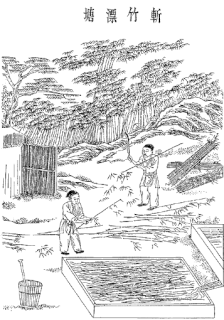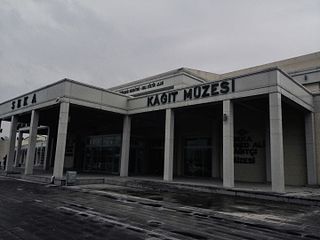
The art, science, and technology of papermaking addresses the methods, equipment, and materials used to make paper and cardboard, these being used widely for printing, writing, and packaging, among many other purposes and useful products. Today almost all paper is manufactured using industrial machinery, while handmade paper survives as a specialized craft and a medium for artistic expression.

Pulp is a lignocellulosic fibrous material prepared by chemically or mechanically separating cellulose fibres from wood, fiber crops, waste paper, or rags. Many kinds of paper are made from wood with nothing else mixed into them. This includes newspapers, magazines and even toilet paper. Pulp is one of the most abundant raw materials.

The pulp and paper industry comprises companies that use wood as raw material and produce pulp, paper, paperboard and other cellulose-based products.

A paper mill is a factory devoted to making paper from vegetable fibres such as wood pulp, old rags and other ingredients. Prior to the invention and adoption of the Fourdrinier machine and other types of paper machine that use an endless belt, all paper in a paper mill was made by hand, one sheet at a time, by specialized laborers.
A paper machine is an industrial machine used in the pulp and paper industry to create paper in large quantities at high speed. Modern paper-making machines are based on the principles of the Fourdrinier Machine, which uses a moving woven mesh to create a continuous paper web by filtering out the fibres held in a paper stock and producing a continuously moving wet mat of fibre. This is dried in the machine to produce a strong paper web.

The kraft process (also known as kraft pulping or sulfate process) is a process for conversion of wood into wood pulp, which consists of almost pure cellulose fibers, the main component of paper. The kraft process entails treatment of wood chips with a hot mixture of water, sodium hydroxide (NaOH), and sodium sulfide (Na2S), known as white liquor, that breaks the bonds that link lignin, hemicellulose, and cellulose. The technology entails several steps, both mechanical and chemical. It is the dominant method for producing paper. In some situations, the process has been controversial because kraft plants can release odorous products and in some situations produce substantial liquid wastes.

Paper craft is the collection of art forms employing paper or card as the primary artistic medium for the creation of three-dimensional objects. It is the most widely used material in arts and crafts. It lends itself to a wide range of techniques, as it can for instance be folded, cut, glued, molded, stitched, or layered. Papermaking by hand is also an important paper craft. Painting and calligraphy though they are commonly applied as decoration are normally considered as separate arts or crafts.

A pulp mill is a manufacturing facility that converts wood chips or other plant fibre source into a thick fibre board which can be shipped to a paper mill for further processing. Pulp can be manufactured using mechanical, semi-chemical or fully chemical methods. The finished product may be either bleached or non-bleached, depending on the customer requirements.

Kraft paper or kraft is paper or paperboard (cardboard) produced from chemical pulp produced in the kraft process.
Coated paper is paper which has been coated by a mixture of materials or a polymer to impart certain qualities to the paper, including weight, surface gloss, smoothness or reduced ink absorbency. Various materials, including Kaolinite, calcium carbonate, Bentonite, and talc can be used to coat paper for high quality printing used in packaging industry and in magazines. The chalk or china clay is bound to the paper with synthetic viscosifiers, such as styrene-butadiene latexes and natural organic binders such as starch. The coating formulation may also contain chemical additives as dispersants, resins, or polyethylene to give water resistance and wet strength to the paper, or to protect against ultraviolet radiation.
The Sartell Paper Mill, officially the Verso Paper Sartell Mill, was a paper mill located in the city of Sartell in the U.S. state of Minnesota, operating from 1905 until a disastrous explosion in 2012.

A deckle is a removable wooden frame or "fence" used in manual papermaking. In a related sense, it can also mean deckle edge paper—a type of industrially produced paper with rough cut edges used in the book trade.

A Hollander beater is a machine developed by the Dutch in 1680 to produce paper pulp from cellulose containing plant fibers. It replaced stamp mills for preparing pulp because the Hollander could produce in one day the same quantity of pulp it would take a stamp mill eight days to prepare.

Paper is a thin material produced by pressing together moist fibres of cellulose pulp derived from wood, rags or grasses, and drying them into flexible sheets. It is a versatile material with many uses, including writing, printing, packaging, cleaning, decorating, and a number of industrial and construction processes. Papers are essential in legal or non-legal documentation.
Deinking is the industrial process of removing printing ink from paperfibers of recycled paper to make deinked pulp.

Paper is a thin unwoven material made from milled plant fibers, is primarily used for writing, artwork, and packaging; it is commonly white. The first papermaking process was documented in China during the Eastern Han period, traditionally attributed to the court official Cai Lun. During the 8th century, Chinese papermaking spread to the Islamic world, where pulp mills and paper mills were used for papermaking and money making. By the 11th century, papermaking was brought to Europe. By the 13th century, papermaking was refined with paper mills utilizing waterwheels in Spain. Later European improvements to the papermaking process came in the 19th century with the invention of wood-based papers.
A shive is a small bundle of incompletely cooked wood fibres in the chemical pulp used in papermaking. They are smaller than knots and are more difficult to separate from the pulp. Typically the content of shives in kraft pulp is 0.1 to 1.0%. An excess of shives is a sign of poor impregnation of the wood chips. Shives are separated from the pulp in the screening and can be added back after refining. Even though shives are darker than rest of the pulp, they may pass unnoticed to the paper machine because they are easily bleached. Shives in the paper machine can cause web breakage or other operational problems. They might also end as spots in the finished paper.
The Herty Advanced Materials Development Center was established in 1938 by the State of Georgia as an applied research center to honor Dr. Charles H. Herty, a chemist whose discoveries spearheaded the utilization of southern softwoods in the manufacture of pulp and paper products. In 2012, Georgia Governor Nathan Deal transferred management of Herty to Georgia Southern University to enhance economic and business development in the State of Georgia.

The SEKA Paper Museum, a.k.a. SEKA Mehmet Ali Kağıtçı Paper Museum, is a museum of industrial heritage in Kocaeli district (İzmit), northwestern Turkey. Situated in a former pulp and paper mill, it is dedicated to papermaking in Turkey. The museum was opened in 2016.

Hemp paper means paper varieties consisting exclusively or to a large extent from pulp obtained from fibers of industrial hemp. The products are mainly specialty papers such as cigarette paper, banknotes and technical filter papers. Compared to wood pulp, hemp pulp offers a four to five times longer fibre, a significantly lower lignin fraction as well as a higher tear resistance and tensile strength. Production costs are much higher than for paper from wood.












